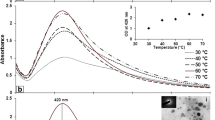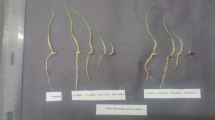Abstract
An experiment was conducted to study the effect of Piper betle leaf extract (PbLE) for prolonging vase life and keeping quality of cut spike of tuberose. Treatments consisted of four vase solutions, viz., distilled water (control), 3 % sucrose (T1), 3 % sucrose + 100 ppm 5-SSA (T2), 3 % sucrose + 50 ppm PbLE (T3). The PbLE in T3 vase solution might have played a significant role to scavenging the reactive oxygen species by inducing antioxidant enzyme system at the time of senescence, leading to decrease in lipid peroxidation and increase the membrane stability. Results suggest that application of T3 vase solution helps to maintain spike fresh and dry weight, improves antioxidative defence, stabilizes membrane integrity leading to delay senescence and thus makes it potential to be used as a commercial vase solution for cut spike of tuberose.



Similar content being viewed by others
References
Arnon, D. I. (1949). Copper enzymes in isolated chloroplasts. Polyphenoloxidase in Beta vulgaris. Plant Physiology, 24, 1–15.
Bieleski, R. L., & Reid, M. S. (1992). Physiological changes accompanying senescence in the ephemeral daylily flower. Plant Physiology, 98, 1042–1049.
Bleeksma, H. C., & van Doorn, W. G. (2003). Embolism in rose stems as a result of vascular occlusion by bacteria. Postharvest Biology and Technology, 29, 335–341.
Bradford, M. (1976). A rapid and sensitive method for the quantification of microgram quantities of protein utilizing the principle of protein–dye binding. Analytical Biochemistry, 72, 248–254.
Brosnan, T., & Sun, D. W. (2001). Precooling techniques and applications for horticultural products-a review. International Journal of Refrigeration, 24, 154–170.
Droillard, M. J., & Paulin, A. (1987). Evolution of polar lipids and catalase and superoxide dismutase activities during the senescence of petals of cut carnations (Dianthus caryophyllus L cv. Ember). Comptos Rendes des Scances Del Academic des Sciences-III Sciences de la vie., 305, 439–442.
Gupta, S. D., & Datta, S. (2003). Antioxidant enzyme activities during in vitro morphogenesis of gladiolus and the effect of application of antioxidants on plant regeneration. Biologia Plantarum, 47, 179–183.
Elhindi, K. M. (2012). Evaluation of several holding solutions for prolonging vase-life and keeping quality of cut sweet pea flowers (Lathyrus odoratus L.). Saudi Journal of Biological Sciences, 19, 195–202.
Ezhilmathi, K., Singh, V. P., Arora, A., & Sairam, R. K. (2007). Effect of 5-sulfosalicylic acid on antioxidant activity in relation to vase life of gladiolus cut flowers. Plant Growth Regulation, 51, 99–108.
Gill, S. S., & Tuteja, N. (2010). Reactive oxygen species and antioxidant machinery in abiotic stress tolerance in crop plants. Plant Physiology and Biochemistry, 48, 909–930.
Halevy, A. H., & Mayak, S. (1981). Senescence and post harvest physiology of cut flowers. Part 2. In J. Janick (Ed.), Horticultural Reviews (pp. 59–141). Hoboken, NJ: Wiley.
Heath, R. L., & Packer, L. (1968). Photo-peroxidation in isolated chloroplast I. kinetics and stoichiometry of fatty acid peroxidation. Archives of Biochemistry and Biophysics, 125, 189–198.
Ho, L. C., & Nichols, R. (1977). Translocation of 14C-sucrose in relation to changes in carbohydrate content in rose corollas cut at different stages of development. Annals of Botany, 41, 227–242.
Kazemi, M., Zamani, S., & Aran, M. (2011a). Effect of some chemical treatments on keeping quality and vase-life gerbera cut flowers. American Journal of Plant Physiology, 6, 99–105.
Kazemi, M., Zamani, S., & Aran, M. (2011b). Interaction between glutamin and different chemicals on extending the vase life of cut flowers of ‘Prato’ lily. American Journal of Plant Physiology, 6, 120–125.
Lichtenthaler, H. K., & Wellburn, A. R. (1983). Determinations of total carotenoids and chlorophylls a and b of leaf extracts in different solvents. Biochemical Society Transactions, 11, 591–592.
Martin, A. B., Cuadrado, Y., Guerra, H., Gallego, P., Hita, O., Martine, L., et al. (2000). Differences in the contents of total sugars, reducing sugars, starch and sucrose in embryogenic and none embrogenic calli from Medicago arborea L. Plant Science, 154, 143–151.
Nalina, T., & Rahim, Z. H. (2007). The crude aqueous extract of Piper betle L. and its antibacterial effect towards Streptococcus mutans. American Journal of Biochemistry and Biotechnology, 3, 10–15.
Nelson, N. (1944). A photometric adaptation of Somogyi method for determination of glucose. The Journal of biological chemistry, 153, 375–379.
Rahman, M.M., Ahmad, S.H., & Lgu, K.S. (2012). Psidium guajava and Piper betle leaf extracts prolong vase life of cut carnation (Dianthus caryophyllus) flowers. The Scientific World Journal. http://dx.doi.org/10.1100/2012/102805.
Reddy, B. S., Singh, K., & Gangadharappa, P. M. (1997). Influence of 8-hydroxy quinoline sulphate and sucrose on post-harvest physiology of tuberose cv.Double. Karnataka Journal of Agricultural Sciences, 10, 1049–1054.
Sairam, R. K. (1994). Effect of moisture stress on physiological activities of two contrasting wheat genotypes. Indian Journal of Experimental Biology, 32, 584–593.
Sairam, R. K., Vasanthan, B., & Arora, A. (2011). Calcium regulates gladiolus flower senescence by influencing antioxidative enzymes activity. Acta physiologiae plantarum, 33, 1897–1904.
Van der Meuler-Muisers, J. J. M., van Overen, J. C., van der Plas, L. H. W., & Van Tuyl, J. M. (2001). Post-harvest flower development in Asiatic hybrid lilies as related to petal carbohydrate status. Postharvest Biology and Technology, 21, 201–211.
Van Meeteren, Y. (1979). Water relations and keeping quality of cut gerbera flowers VI. Water content, permeability and dry weight of ageing petals. Scientia Horticulturae, 10, 261–269.
Weatherley, P. E. (1950). Studies in water relations of cotton plants I. The field measurement of water deficit in leaves. New Phytologist, 49, 81–97.
Woodson, W. R., & Handa, A. K. (1987). Changes in protein patterns and in vivo protein synthesis during pre-senescence and senescence of Hibiscus petals. Journal of Plant Physiology, 128, 67–75.
Yamane, K., Abiru, S., Fujishige, N., Sakiyama, R., & Ogata, R. (1993). Export of soluble sugars and increase in membrane permeability of cut gladiolus florets during senescence. Journal of the Japanese Society for Horticultural Science, 62, 575–580.
Zamani, S., Kazemi, M., & Aran, M. (2011). Postharvest life of cut rose flowers as affected by salicylic acid and glutamin. World Applied Sciences Journal, 12, 1621–1624.
Acknowledgments
The work is supported by the grant aided by Science and Engineering Research Board, Government of India (SR/FT/LS-102/2010). The authors express their sincere gratitude to Anonymous Reviewer(s) for their valuable suggestion, which helped the article to be enriched.
Author information
Authors and Affiliations
Corresponding author
Rights and permissions
About this article
Cite this article
Maity, T.R., Samanta, A., Jana, D. et al. Effect of Piper betle leaf extract on post-harvest physiology and vascular blockage in relation to vase life and keeping quality of cut spike of tuberose (Polianthes tuberosa L. cv. Single). Ind J Plant Physiol. 19, 250–256 (2014). https://doi.org/10.1007/s40502-014-0110-y
Received:
Accepted:
Published:
Issue Date:
DOI: https://doi.org/10.1007/s40502-014-0110-y




